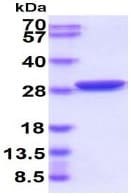Recombinant A. victoria GFP protein (ab84191)
Key features and details
- Expression system: Escherichia coli
- Purity: > 95% SDS-PAGE
- Endotoxin level: < 1.000 Eu/µg
- Active: Yes
- Suitable for: SDS-PAGE, WB, Functional Studies
Description
-
Product name
Recombinant A. victoria GFP protein
See all GFP proteins and peptides -
Purity
> 95 % SDS-PAGE.
Purified using conventional chromatography techniques. -
Endotoxin level
< 1.000 Eu/µg -
Expression system
Escherichia coli -
Accession
-
Protein length
Full length protein -
Animal free
No -
Nature
Recombinant -
-
Species
Aequorea victoria -
Sequence
MSKGEELFTG VVPILVELDG DVNGHKFSVS GEGEGDATYG KLTLKFICTT GKLPVPWPTL VTTFSYGVQC FSRYPDHMKQ HDFFKSAMPE GYVQERTIFF KDDGNYKTRA EVKFEGDTLV NRIELKGIDF KEDGNILGHK LEYNYNSHNV YIMADKQKNG IKVNFKIRHN IEDGSVQLAD HYQQNTPIGD GPVLLPDNHY LSTQSALSKD PNEKRDHMVL LEFVTAAGIT HGMDELYK -
Predicted molecular weight
27 kDa -
Amino acids
1 to 238 -
Additional sequence information
(AAA27721) MW confirmed by MALDI-TOF.
-
-
Description
Recombinant A. victoria GFP protein
Associated products
-
Related Products
- Anti-GFP antibody [9F9.F9] (ab1218)
- Anti-GFP antibody (ab13970)
- GFP ELISA Kit (ab171581)
- Anti-GFP antibody (ab290)
- Anti-GFP antibody [LGB-1] (ab291)
- Anti-GFP antibody (ab5450)
- Anti-GFP antibody (ab6556)
- Biotin Anti-GFP antibody (ab6658)
- FITC Anti-GFP antibody (ab6662)
- HRP Anti-GFP antibody (ab6663)
- Anti-GFP antibody (ab6673)
Specifications
Our Abpromise guarantee covers the use of ab84191 in the following tested applications.
The application notes include recommended starting dilutions; optimal dilutions/concentrations should be determined by the end user.
-
Applications
SDS-PAGE
Western blot
Functional Studies
-
Mass spectrometry
MALDI-TOF -
Form
Liquid -
Additional notes
Endotoxin Level determined by LAL method.
Concentration determined by Bradford assay.
-
 Concentration information loading...
Concentration information loading...
Preparation and Storage
-
Stability and Storage
Shipped at 4°C. Store at +4°C short term (1-2 weeks). Upon delivery aliquot. Store at -20°C or -80°C. Avoid freeze / thaw cycle.
pH: 8.00
Constituents: 0.316% Tris HCl, 10% GlycerolThis product is an active protein and may elicit a biological response in vivo, handle with caution.
General Info
-
Alternative names
- GFP
- Green fluorescent protein
-
Relevance
Function: Energy-transfer acceptor. Its role is to transduce the blue chemiluminescence of the protein aequorin into green fluorescent light by energy transfer. Fluoresces in vivo upon receiving energy from the Ca2+ -activated photoprotein aequorin.
Subunit structure: Monomer.
Tissue specificity: Photocytes.
Post-translational modification: Contains a chromophore consisting of modified amino acid residues. The chromophore is formed by autocatalytic backbone condensation between Ser-65 and Gly-67, and oxidation of Tyr-66 to didehydrotyrosine. Maturation of the chromophore requires nothing other than molecular oxygen.
Biotechnological use: Green fluorescent protein has been engineered to produce a vast number of variously colored mutants, fusion proteins, and biosensors. Fluorescent proteins and its mutated allelic forms, blue, cyan and yellow have become a useful and ubiquitous tool for making chimeric proteins, where they function as a fluorescent protein tag. Typically they tolerate N- and C-terminal fusion to a broad variety of proteins. They have been expressed in most known cell types and are used as a noninvasive fluorescent marker in living cells and organisms. They enable a wide range of applications where they have functioned as a cell lineage tracer, reporter of gene expression, or as a measure of protein-protein interactions. Can also be used as a molecular thermometer, allowing accurate temperature measurements in fluids. The measurement process relies on the detection of the blinking of GFP using fluorescence correlation spectroscopy.
Sequence similarities: Belongs to the GFP family.
Biophysicochemical properties: Absorption: Abs(max)=395 nm
Exhibits a smaller absorbance peak at 470 nm. The fluorescence emission spectrum peaks at 509 nm with a shoulder at 540 nm.
Images
-
1. Prepare a 150 μl recombinant GFP with various concentrations (0.00074 nM - 6.21 μM) in assay buffer and equilibrate to 25°C. (Assay buffer: 10 mM Tris-HCl (pH 8.0), 10 mM EDTA, 0.02% sodium azide.)
2. Read at excitation wavelengths 485 nm and emission 535 nm.
- 96 Well Polystyrene Microplate, black
- Fluorescent plate reader
-
3 ug of reduced ab84191 on SDS-PAGE, stained with Coomassie Blue.
Protocols
To our knowledge, customised protocols are not required for this product. Please try the standard protocols listed below and let us know how you get on.
Datasheets and documents
-
SDS download
-
Datasheet download
References (7)
ab84191 has been referenced in 7 publications.
- Becker-Gotot J et al. Immune tolerance against infused FVIII in hemophilia A is mediated by PD-L1+ Tregs. J Clin Invest 132:N/A (2022). PubMed: 36107620
- Borberg E et al. Ultrafast one-minute electronic detection of SARS-CoV-2 infection by 3CLpro enzymatic activity in untreated saliva samples. Nat Commun 13:6375 (2022). PubMed: 36289211
- Jay TR et al. An ELISA-based method for rapid genetic screens in Drosophila. Proc Natl Acad Sci U S A 118:N/A (2021). PubMed: 34686600
- Begeman A et al. G-Quadruplexes act as sequence-dependent protein chaperones. EMBO Rep 21:e49735 (2020). PubMed: 32945124
- Shiota M et al. Gold-nanofève surface-enhanced Raman spectroscopy visualizes hypotaurine as a robust anti-oxidant consumed in cancer survival. Nat Commun 9:1561 (2018). PubMed: 29674746
- Arrant AE et al. Progranulin Gene Therapy Improves Lysosomal Dysfunction and Microglial Pathology Associated with Frontotemporal Dementia and Neuronal Ceroid Lipofuscinosis. J Neurosci 38:2341-2358 (2018). PubMed: 29378861
- Nabeshima R et al. Loss of Fam60a, a Sin3a subunit, results in embryonic lethality and is associated with aberrant methylation at a subset of gene promoters. Elife 7:N/A (2018). PubMed: 30070635


